Fighting sea giants. First in class
The great ships of the twentieth century from the Cunard Line, White Star, Nordeutscher Lloyd and Hamburg - Amerika became the material embodiment of the technical revolution, prototypes that served as models for the shipbuilders of the future.
At the end of the XNUMXth century, Atlantic liners underwent a major transformation. Previously, they were only an unpleasant, inconvenient and slow means of crossing the ocean, but now they suddenly became symbols of luxury, power and strength.
Each ship, in turn, has become a legend. Some have achieved this mythical status for their excellent track record, both in peacetime and in wartime, others are remembered for their disasters and shameful destinies.
Stories about them, their stories striking, fascinating and inextricably linked with the world history of the first half of the twentieth century.
Fighting giants
Article "The fate of people and the fate of ships" I have already talked about the German entrepreneur Albert Ballina, who back in 1890 proposed the idea of cruise flights. At that time they frankly laughed at him and said that he was crazy.
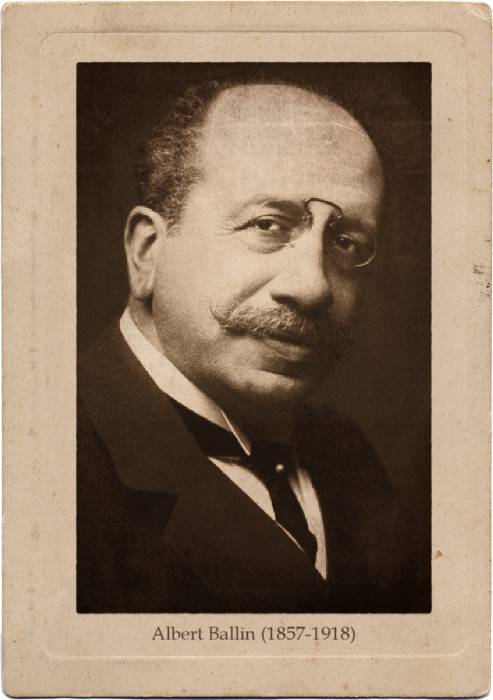
In fact, this notion arose as a solution to an important logistical problem. The North Atlantic is an uncomfortable place in winter: cold, rain, storms, huge waves. Therefore, the number of passengers wishing to travel to America dropped sharply during the winter months. So that ships and crews did not stand idle, they had to find a new job.
Ballin was the first to realize that there are a large number of rich people who are willing to pay for new entertainment, and gave them this entertainment. Cruise ships were not only equipped with powerful cars and the best navigation devices. They also impressed passengers with the luxury of decoration and many pleasant things, without which the harsh sailors, of course, could do.
HAPAG (Hamburg - Americanische Pucketfart Aktien-Gesellschaft), also known as Hamburg - America Line, has signed a contract with Vulcan AG for the construction of a passenger liner, the first German ship in its class - Augusta Victoria, in honor of the wife of Kaiser Wilhelm II.
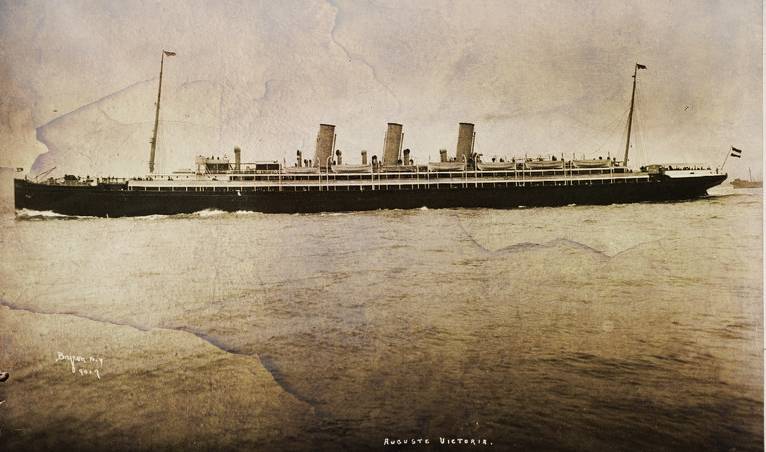
The world's first pleasure cruise, on board a luxury steamer, 241 passengers, including the owner himself Albert Ballin and his wife Marianne, made in 57 days 11 hours and three minutes.
Ballina's guests loved the first class cabins. There was also excellent cuisine and a daily newspaper printed on board. The ship called at more than a dozen ports (complete with shore excursions), starting from Southampton on the southern coast of Great Britain, through the Strait of Gibraltar, Mediterranean ports of call, including Genoa, Alexandria, Jaffa, Beirut, Constantinople (now Istanbul), Athens, Malta, Naples and Lisbon. The cruise was rated highly successful.
Since then, HAPAG has offered similar cruises every year.
These sea cruises to exotic destinations are considered the norm today, but at the end of the XNUMXth century it was an innovative idea.
On July 4, 1900, the HAPAG company goes to sea with the 16th ocean liner Deutschland.
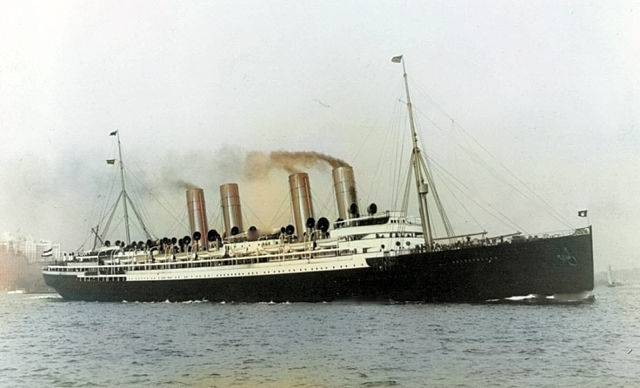
It is not the largest liner at the time, but at 23 knots, it is fast enough to rob the Atlantic Blue Ribbon, a challenge prize awarded to ocean liners for record average speed across the North Atlantic, rival German line Norddeutscher Lloyd and their 1897 liner. year of manufacture - Kaiser Wilhelm der Grosse.
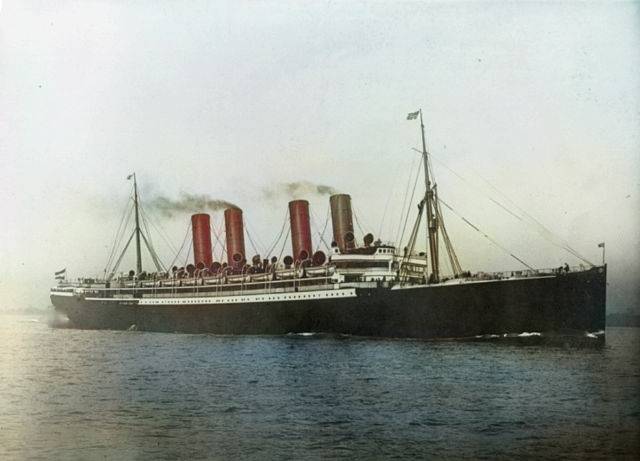
Deutschland was distinguished by significantly improved design and luxury hitherto unseen on ships compared to the Kaiser Wilhelm der Grosse.
The public halls are wide, and the spacious and cozy café had a magnificent dome - a glass transparent ceiling with intricate decorative cruciform framing. It was almost the perfect ship for ushering in the new century.
In 1901, a year after launching, Deutschland yields the speed record to German rival Nordeutscher Lloyd and their newest liner Kronprinz Wilhelm.
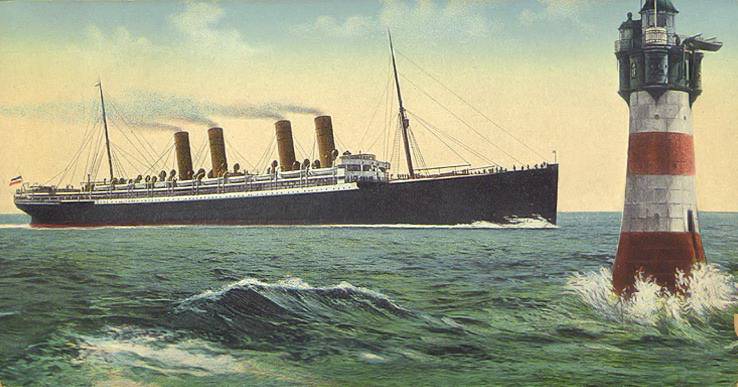
Fast Deutschland has no problem getting the Blue Ribbon back and saving it quickly. She will remain the record holder for another five years.
The first demonstration of Hamburg's new strategy - Amerika: “luxury over speed” - is the 1905 Amerika liner, which departed for its maiden voyage on 11 October.
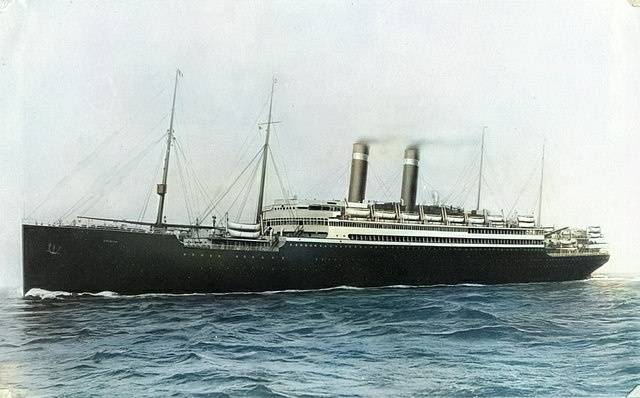
With a tonnage of 22 gross tonnes, Amerika was the second largest vessel in the world after the 225 White Star's 23 tonne Baltic liner.
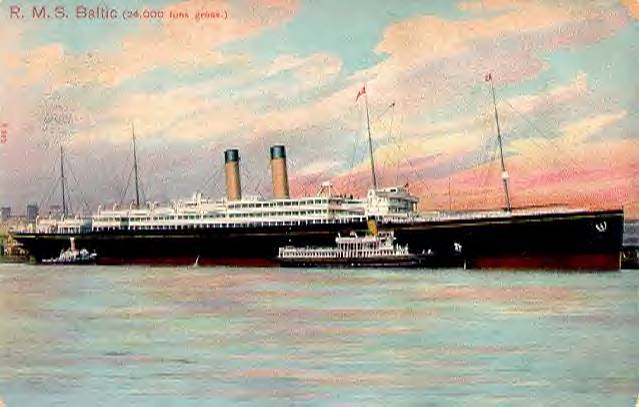
Amerika dazzled with lavish interiors, including the first ever electric boat lifts and the Ritz Carlton à la carte restaurant, designed by world renowned architect Charles Mewes, who will feature prominently in future Amerika Line projects.
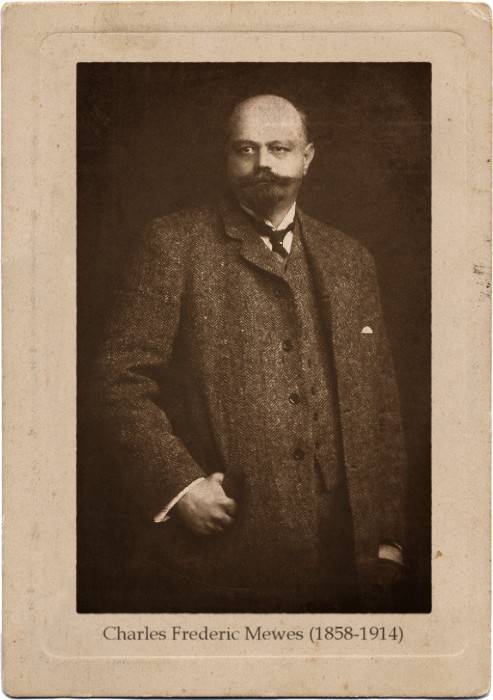
1906 comes, and on May 10, the 705-foot (214,9 m) 24-ton giantess Kaiserin Auguste Victoria (named after the Empress of Germany) embarks on her maiden voyage to the ocean.
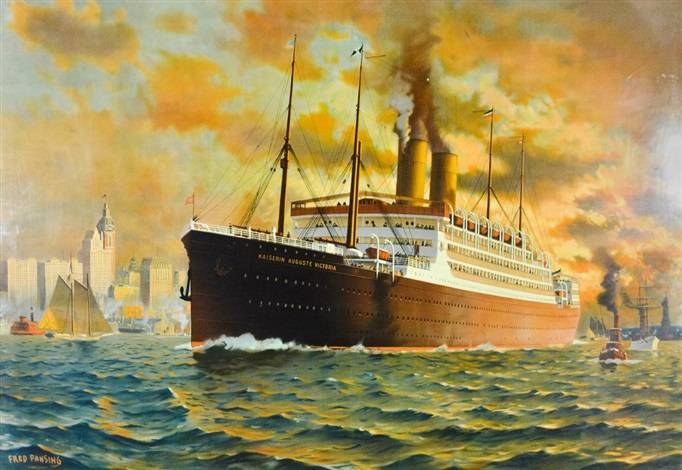
Outside, too many decks give it an unattractive look, but inside, Hamburg-Amerika believes, is exquisite luxury. Like Amerika, it was also designed by Charles Mewes.
Thanks to this latest addition fleetHamburg - The Amerika Line can now claim to operate the largest and fastest liner in the world. But the size and speed of these magnificent liners hold prestige for just a year before Amerika Line, as well as its rivals Norddeutscher Lloyd and White Star Line, face two formidable new contenders for the Atlantic race.
1907 is the year when the epitome of luxury and size is combined with modern speed: two British heavyweight giants, Lusitania and Mauretania, are launched.
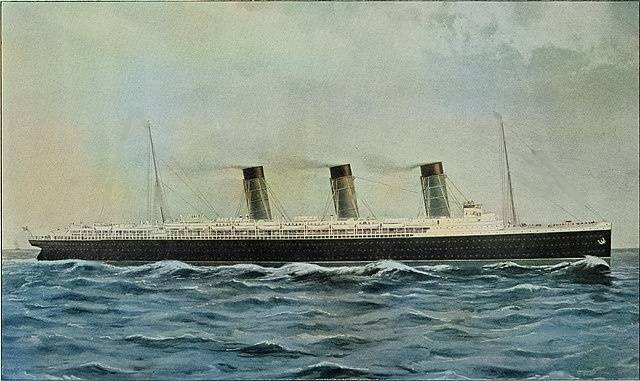
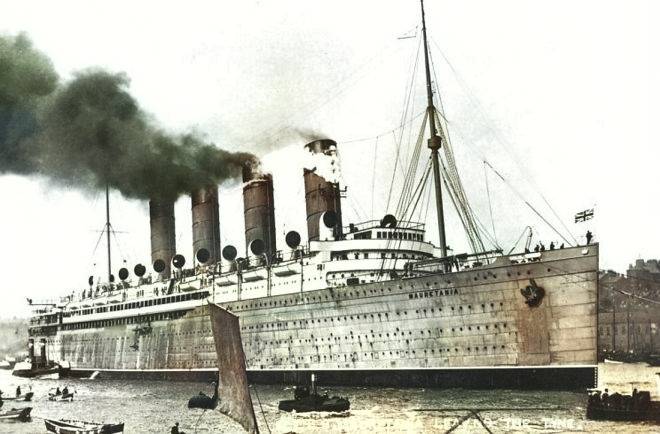
With state-of-the-art turbines, the 790-foot (240,8 m) Mauretania, with 31 gross tonnage, is the largest and fastest liner in the world with an estimated operating speed of 938 knots (and even 25 knots during testing). In the open sea). Its speed, even surpassing that of its sister, was made possible by the modernization of the power plant in 27,75.
To build these two great liners, the fledgling Cunard Line had to use government loans. But the risk was worth the result. They escaped the power-hungry White Star Line and also crushed German supremacy in the North Atlantic.
With the advent of the Lusitania and Mauretania, it became apparent to Cunard that a new era of ocean liners had arrived, and now being the best means creating ships that are nothing more than masterpieces in their own right. The Cunard Line sparked a new commercial race, and after that, the stakes began to skyrocket.
Cunard's rival White Star Line understands this and orders three ships of unheard-of size, over 45 gross tonnage, to usurp the Atlantic throne from the Cunard Line. They will be known as Olympic, Titanic and Britannic.
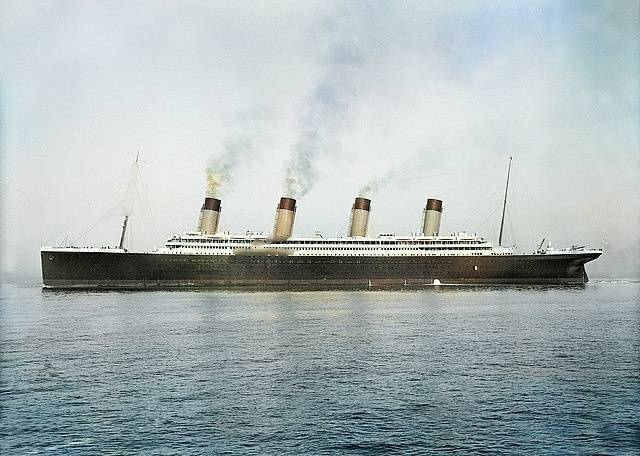
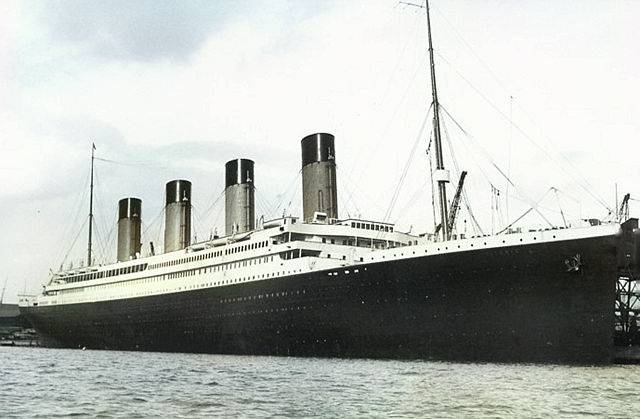
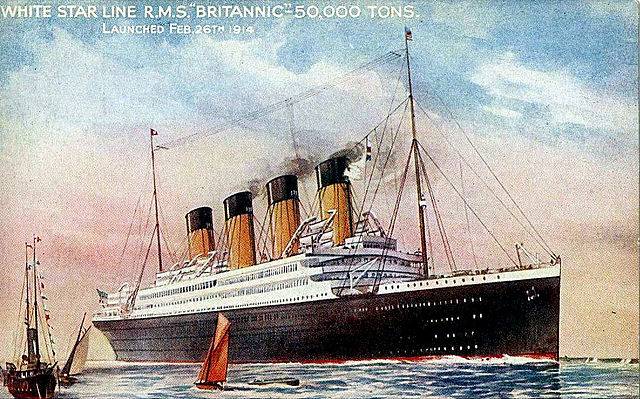
Hamburg - Amerika, despite the largest stock of liners on the lines, began to fear for its prestige.
What if she will never again fly either the largest or the fastest ocean liner?
This could mean both a serious loss of national prestige and losses for business.
First in class
And so, the new millennium ended its first decade. It was an exciting time for the ocean liner industry.
The competition between the British and the Germans for the best liners in the world reached a new peak, and this was in line with the spirit of the times and increased the excitement caused by the launch of each new vessel.
Albert Ballin, President of Hamburg - Amerika, decides to act. He is canceling plans to build a 44-ton ship by Belfast-based Harland & Wolff, as he believes the ship will not be large enough or impressive enough compared to the 000-knot Mauretania and the 25-ton White Star Olympic and Titanic liners.
Ballin lays out a new strategy.
His plans include the construction of three giants, each with a tonnage of over 50 gross tons, a length of over 000 feet (900 m) and more luxurious than any ship before them. They will be released under the names Imperator, Vaterland and Bismarck. The Imperator will be built first, and the whole trio will be named so: "Imperator class liners". They will be the “sea symphony of steel” that will put Hamburg - Amerika Line at the forefront of merchant shipping for the next decade and beyond.
It was June 18, 1910, a few months before the launch of Olympic, the first of the three White Star Line giants, and the second in their line, the Titanic, had been under construction for a year.
However, with all due respect, both Olympic and Titanic have already turned into liners of "modest" dimensions, because on that day at the Vulcan Shipyards in Hamburg, the keel of the huge Imperator liner, so far known only as Hull 314, was laid. It will be the first ship exceeding 900 feet in length and 50 tons gross tonnage, and the first German liner to have four propellers.
It will have public spaces larger, higher and more luxurious than any other ship in the world, and will now be able to claim to carry more passengers than any liner in history.
To feel all the grandeur of the plans, just imagine that the shipyard during the construction process required 25 tons of steel, 000 tons of rivets and 1 cubic meters of the best light Oregon fir in America. In a batch of 500 logs, they were sent even uncouth and then cut and fitted in Germany.
The huge frame consisted of 654 steel frames (327 on each side).
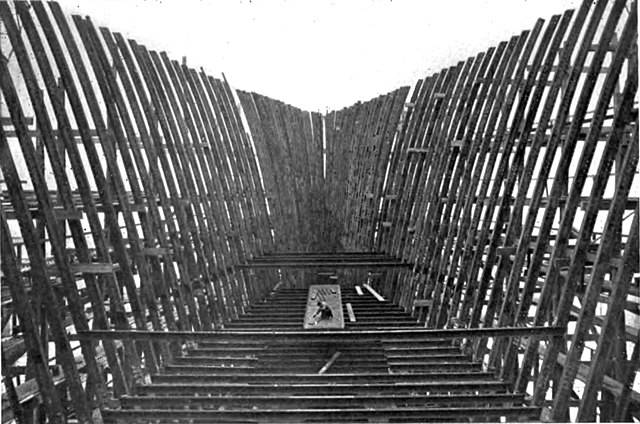
As construction nears completion, the sinking of the Titanic will shake the world.
Determined never to allow such an incident to compromise the reputation of the world's largest shipping company, Ballin demanded that the designers and builders place a "second shell" five feet from the outer shell of the Emperor's hull, effectively making it a ship within a ship. This second planking ran the entire length of the hull, and its bulkheads were of exceptional strength and height.
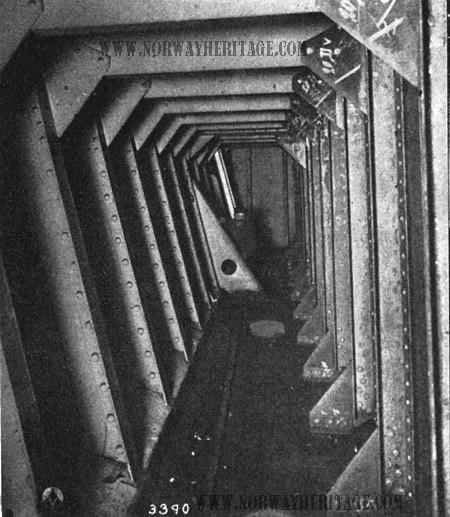
Published with the kind permission of the Norwegian Heritage website.
There were twelve watertight bulkheads and thirteen transverse watertight compartments. The watertight bulkheads were equipped with thirty-six watertight doors and rose to Deck H, 55 feet (16,7 m) above the keel.
Twenty-three of these thirty-six watertight doors were hydraulically operated using a patented Dorr system. This system made it possible to close the watertight doors either from the command bridge or using auxiliary controls from the upper deck.
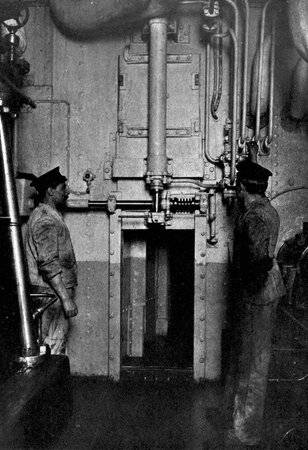
In addition, electrical sirens allowed the captain and his officers to ensure that their orders were correctly received and followed, making it possible to organize a force capable of taking immediate action in any situation.
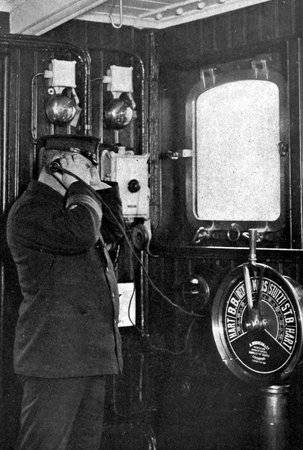
The ship's bulkheads supported strong I-beams weighing from one to 4,5 tons.
By dividing the vessel into various watertight compartments, safety was ensured even if two or more adjacent compartments were filled with water. To prove the effectiveness of the bulkheads, Vulcan Shipyards asked the Hamburg Fire Department to use one of their fire engines to fill several compartments in the inner hull.
Longitudinal bulkheads located next to the four boiler houses formed huge side bunkers, which contained about 8 tons of coal, which 500 people threw into the furnaces. Coal bunkers were located above the boilers on decks 422 and 4. Deep below on deck 5 was another coal bunker. To remove slag from coal combustion, on deck 7, adjacent to the bunkers, there were five devices capable of utilizing 4 cubic meters of slag per hour.
The four boiler rooms were 74 feet 9 inches (22,6 m) long. 46 water tube boilers of the Yarrow type were installed in these boiler houses.
The boilers were rated at 235 psi. in forced draft and powered four pairs of Curtis AEG Vulcan direct drive steam turbines. Hamburg - Amerika became the first commercial shipping line to use such boilers on superliners.
The first two pipes on the ship were used for their intended purpose. The third pipe was a snag and was used for ventilation of boiler rooms. The air was extracted through the vertical shafts of the ventilation shafts using electric fans. After that, four fans with impellers with a diameter of 2,5–3 meters expelled air through a third pipe.
The forward engine room was 65 feet (19,8 m) long and was divided into three watertight spaces by two bulkheads. On the starboard side there is a cooling unit. The rear engine room was 95 feet (29,8 m) long and separated by a single bulkhead. As in the boiler rooms, three fans provided ventilation for the engine rooms.
The front engine room had two low-pressure turbines. They weighed 380 tons each. The rear engine room housed high and medium pressure turbines. Each of them weighed 135 tons. The high pressure turbines in the rear engine room had 50 blades. The turbine casings were 000 feet (18 m) in diameter and 5,5 feet (25 m) long. Six oil pumps continuously supplied lubrication to the turbines.
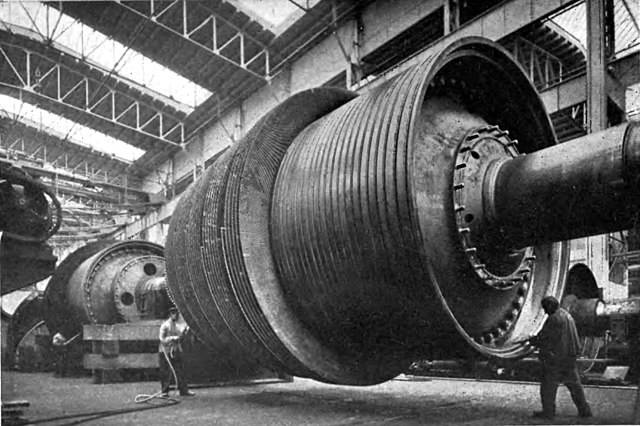
The turbines produced 72 horsepower (000 in reverse) and propelled the Imperator at an average speed of 35 ½ knots.
Each of the four propellers was 1 ½ feet (0,45 m) in diameter, and the four bronze propellers were 16 feet (4,87 m) in diameter, and were operating at full power at 185 rpm. Each propeller could operate independently.
In case of any malfunctions, minor preventive or necessary repairs, there was a well-equipped mechanical repair shop in the rear engine room, in which drilling, turning, planing, milling and grinding machines were installed. Chain and electric winches were attached to the ceiling beams.
On the port side, in the aft engine room, there were five powerful turbine generators with a voltage of 110 volts to power the engines, lifeboat winches, the ventilation system, all the ship's lighting equipment and all the heating of the saloons and cabins. The emergency gasoline generator was on the boat deck.
There was no doubt that the new Hamburg-Amerika liner would be the heaviest ever built. Its rudder alone weighed 90 tons, and the stock with levers and control shafts - 110 tons.
The Imperator was so huge that two conventional drydocks had to be connected to build it.
And yet whether it will be the longest liner in the world was a completely different question.
At that time, the Cunard line was already developing plans for its third ship, Aquitania, and its dimensions, especially the length, were kept under the strictest confidence. Nevertheless, Albert Ballin was confident that his new liner would be longer, but he did not risk it.
As an ingenious insurance plan for the length of his new liner, Ballin commissioned Dr. Bruno Kruse, one of Berlin's finest sculptors, to sculpt a 10,3-foot (3,1 m), 16-meter wingspan, out of gilded bronze, a German eagle with a huge the globe. Eighteen rays emanated from the ball, which attached a massive figure to the stem. The band around this globe bears the Hamburg-Amerika motto: “My field is the world” (Mein Feld ist die Welt).
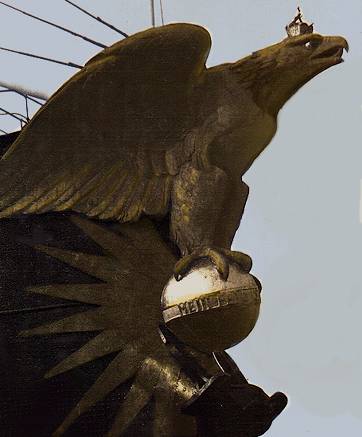
The sculpture will be installed after the launch of the liner.
And when the installation is complete, the vessel will be 919,3 feet (280,2 m) long, making the Imperator the longest liner in the world at that time.
Sources:
Atlantic Liners: A Trio of Trios J. Kent Layton, 2005
The Hamburg-American Company's New 50,000-Ton Liner (International Marine Engineering)
Robert D. Ballard, Ken Marschall: Lost Liners - Von der Titanic zur Andrea Doria - Glanz und Untergang der großen Luxusliner. München, 1997
Arnold Kludas: Die deutschen Schnelldampfer. Die Imperatorklasse - Höhepunkt einer Epoche
Eberhard Mertens: Imperator-class Hapag giants
Wikipedia articles, etc.
All images in this article are taken from the Wikipedia media warehouse, the Flikr free images resource and the like, unless otherwise stated.
To be continued ...

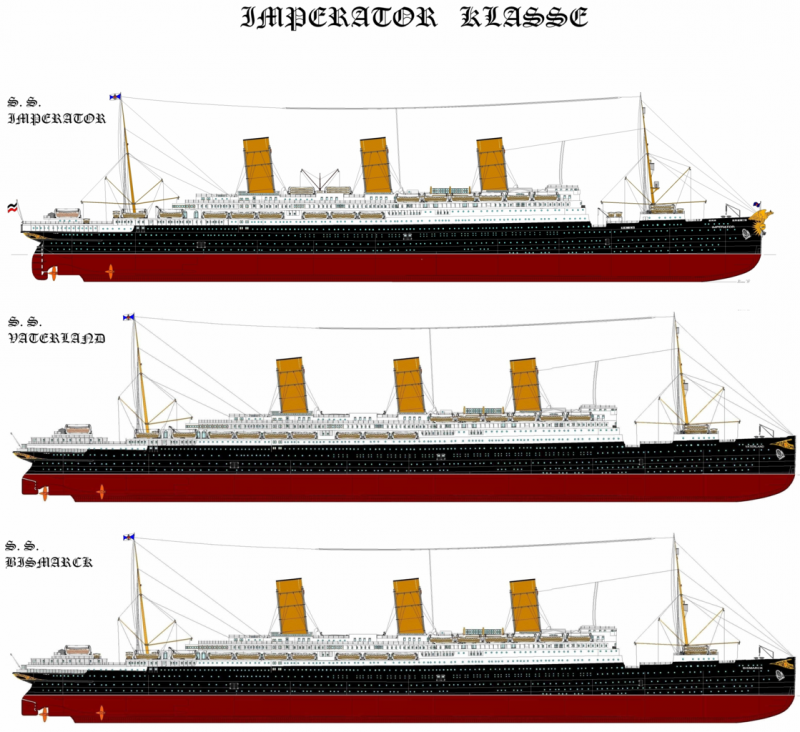
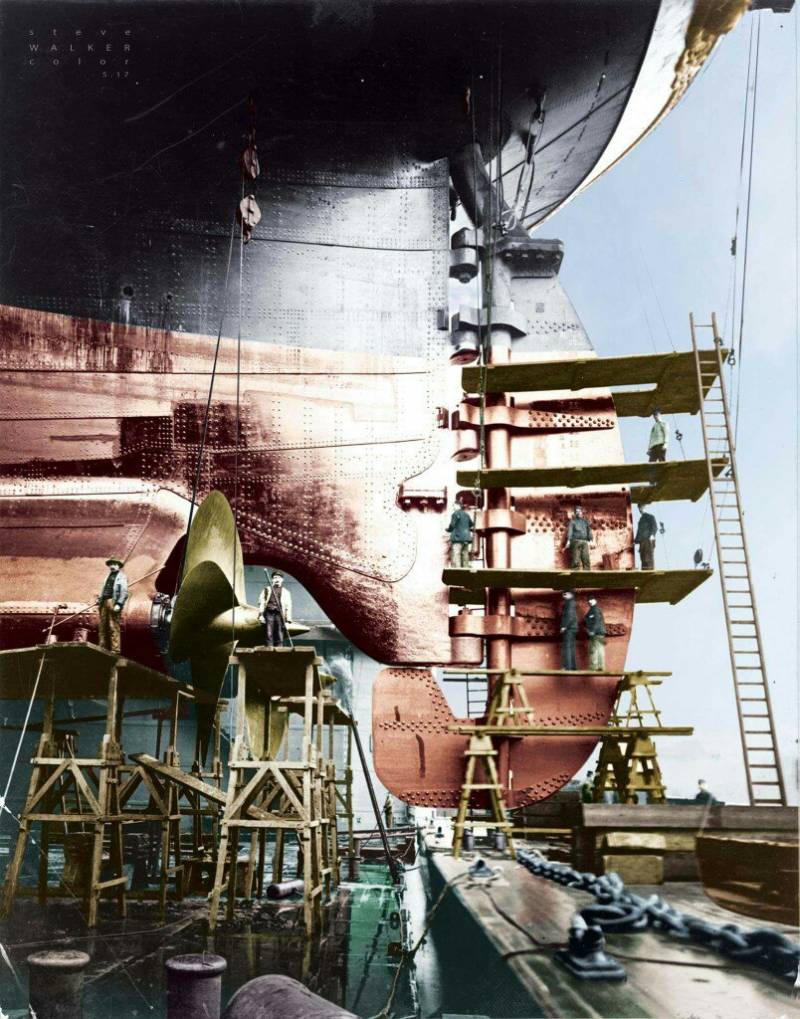
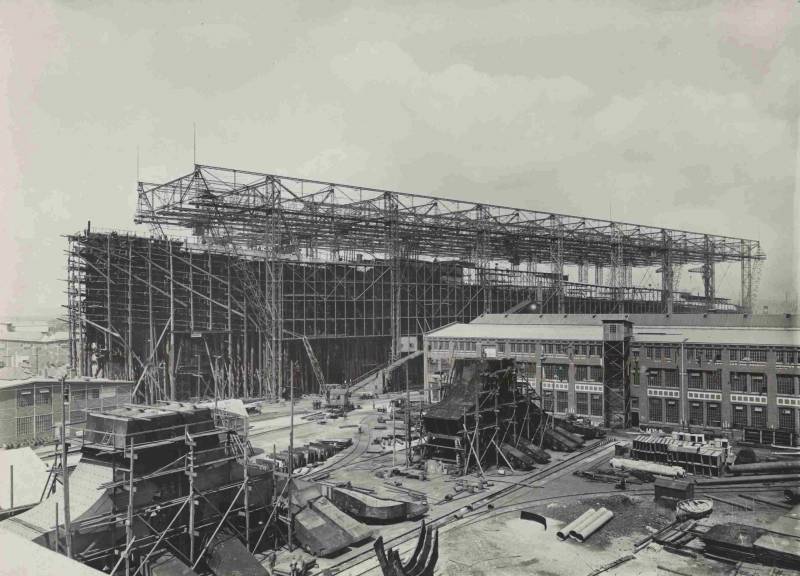
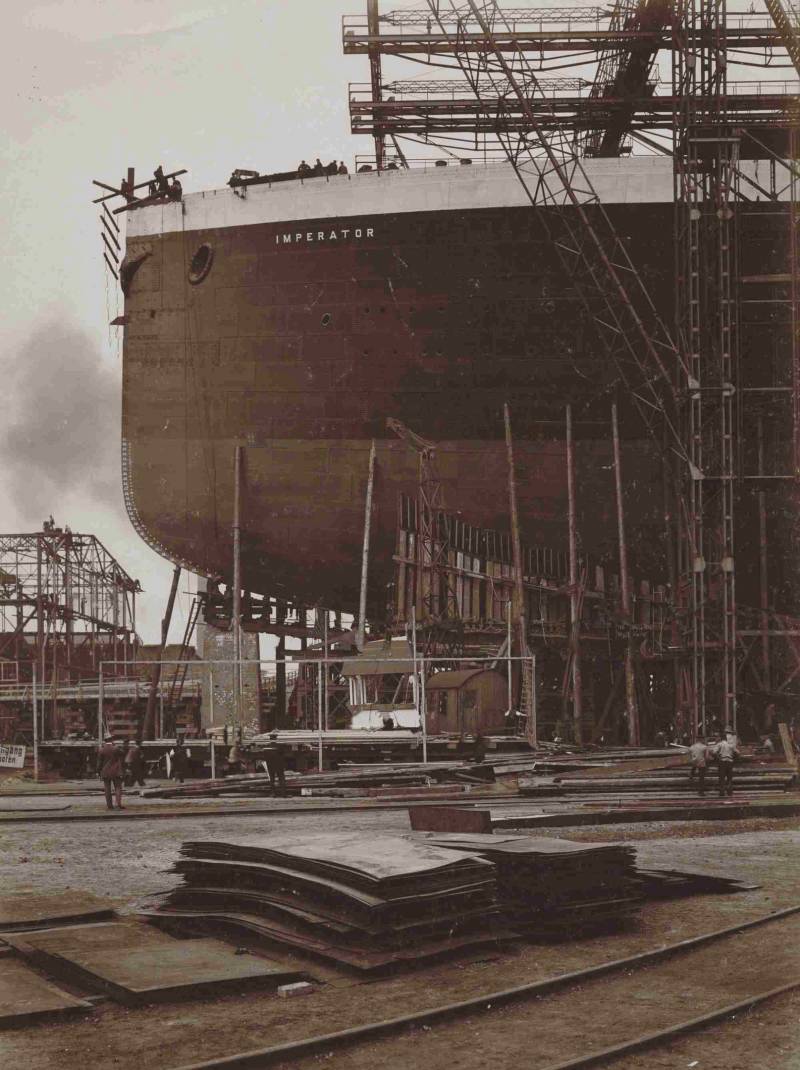
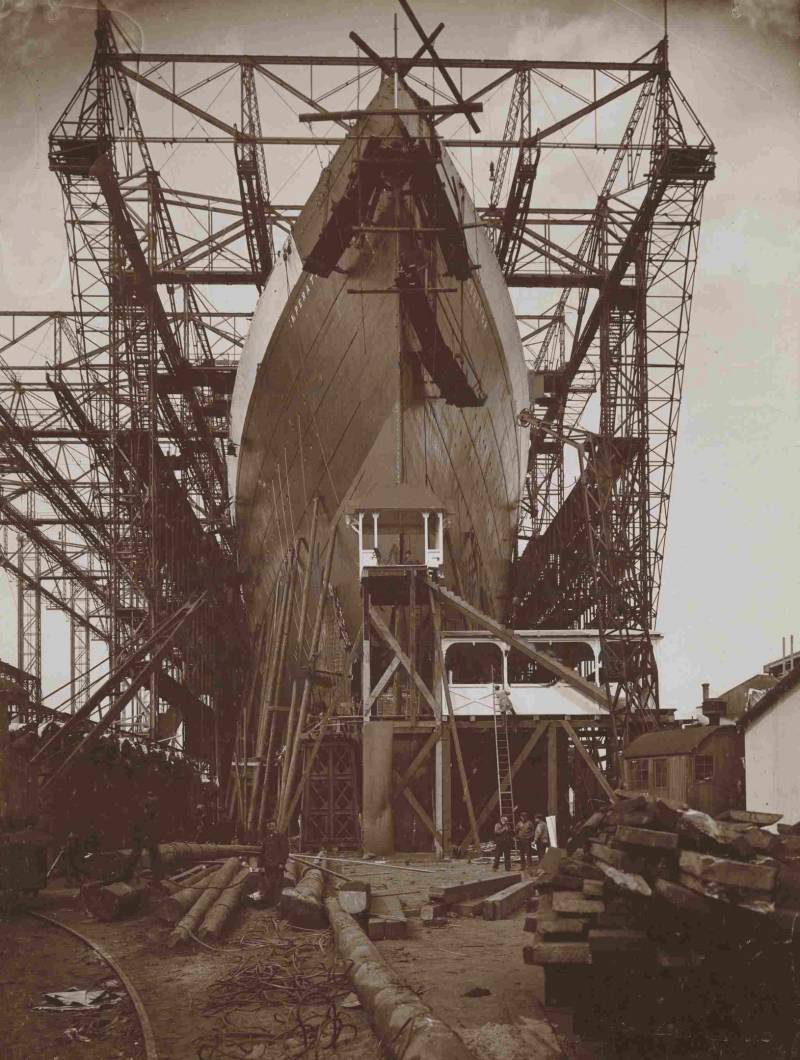
Information